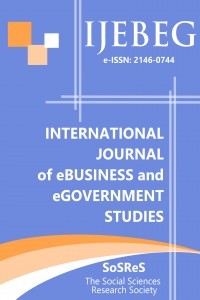FACTORS INFLUENCING A NEW INFORMATION AND COMMUNICATION TECHNOLOGY ADOPTION IN MALAYSIA’S AGRICULTURE COMMUNITY: APPLYING THE SUSTAINABLE LIVELIHOODS APPROACH
FACTORS INFLUENCING A NEW INFORMATION AND COMMUNICATION TECHNOLOGY ADOPTION IN MALAYSIA’S AGRICULTURE COMMUNITY: APPLYING THE SUSTAINABLE LIVELIHOODS APPROACH
___
- Barclay, D. W., Thompson, R., & Higgins, C. (1995). The Partial Least Square
- (PLS) Approach to Causal Modeling: Personal Computer Adoption and Use an Illustration. Technology Study, 2(2), 283-309. Baron, R. M., & Kenny, D. A. (1986). The Moderator-Mediator Variable
- Distinction in Social Psychological Research: Conceptual, Strategic and Statistical Considerations. Journal of Personality and Social Psychology, 1173-1182.
- Chambers, R., & Conway, G. (1992). Sustainable Rural Livelihoods: Practical
- Concepts for the 21st Century. Brighton: IDS. Compeau, D. R., Higgins, C. A., & Huff, S. (1999). Social Cognitive Theory and Individual Reactions to COmputing Technology: A Longitudinal Study.
- Management of Information System, 23(2), 145-158. Deparment for International Development of the United Kingdom. (1999).
- Sustainable Livelihoods Guidance Sheet. UK: Overseas Development Institute. Hair, J. F., Black, W. C., Babin, B. J., & Anderson, R. E. (2010). Multivariate
- Data Analysis. Upper Saddle River: Prentice-Hall. Sobel, M. (1982). Asymptotic Confidence Intervals For Indirect Effects on
- Structural Equation Models. In S. Leinhardt, Sociological Methodology (pp. 290- ). New York: Jossey-Bass.
- Başlangıç: 2009
- Yayıncı: Sosyal Bilimler Araştırmaları Derneği
TECHNOLOGICAL CHANGE IN A SMALL EUROPEAN COUNTRY: A PATENT- BASED ANALYSIS FOR GREECE
Lynda Priscilla Vincent Richard
Daniel K.N. Johnson, Kristina M. Lybecker, Jeffrey Moore
HOW MARKETING AND CUSTOMERS WILL BE AFFECTED BY CLOUD COMPUTING?
MODERN ECONOMY, ELECTRONIC FINANCIAL MARKETS AND ECONOMIC GROWTH IN SELECTED COUNTRIES
Monireh Dizaji, Naghmeh Sharifi, Fahimeh Esmaeli, Mina Mahjoub Laleh
CYBERLOAFING PHENOMENON IN ORGANIZATIONS: DETERMINANTS AND IMPACTS
Derya Ergun OZLER, Gulcin POLAT
Caroline Rosie Jeffrey Nasah, Minah Japang, Goh Say Leng
ORGANIZATIONAL ADOPTION OF INFORMATION TECHNOLOGIES: A LITERATURE REVIEW
Ibrahim Arpaci, Yasemin Cetin Yardimci, Sevgi Ozkan, Ozgur Turetken
EXPLORING A NEW ELECTRONIC RETAILING TREND IN TURKEY AND THE WORLD: PRIVATE SHOPPING
